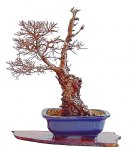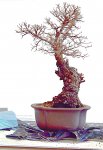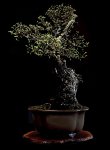You are using an out of date browser. It may not display this or other websites correctly.
You should upgrade or use an alternative browser.
You should upgrade or use an alternative browser.
Ulmus Parvifolia Corticosa Monster Elm
- Thread starter fredtruck
- Start date
fredtruck
Omono
No, almost all the functioning roots were at the rear of the tree. Elm wood is rock hard, in general. I just removed the rot until I reached the very solid core. I did reposition and retie my tie wires. I think it will be a long time before I have more rot issues.
fredtruck
Omono
The development of hollows under the tree led to the further discovery of a massive nebari. I had no idea it existed when I began working with this cork bark elm. After looking at it for several months, I decided I wanted to feature the nebari. This meant moving my carving to the rear of the tree, but in the autumn and winter, my deadwood work still comes into play. Another thing that happened when I rotated the tree was the many spikes left by pruned shoots and branches became more visible. While display of this feature creates a wing-like protuberance, I feel it fits the character of the elm--rough and maybe a bit rude. See what you think.


"Super quote! "often I feel it is expressed as a passive power, rope-a-doping the forces of nature">>I have to say, that I've never seen what others see in these. To me they are just plain oogly. But you may have a plan to change that, keep us posted.
A more thought-provoking approach to my tree would be to consider it as an expression of power. Power to what end? The will to survive is often mentioned as a characteristic of bonsai, but too often I feel it is expressed as a passive power, rope-a-doping the forces of nature. My tree is in the fight. My tree is more like: strike me with lightening, burn me up, hit me with ice, and I will hit you twice as hard in the spring with new growth and live another 700 years.
Your direction as displayed in the picture is so much better and evocative!The development of hollows under the tree led to the further discovery of a massive nebari. I had no idea it existed when I began working with this cork bark elm. After looking at it for several months, I decided I wanted to feature the nebari. This meant moving my carving to the rear of the tree, but in the autumn and winter, my deadwood work still comes into play. Another thing that happened when I rotated the tree was the many spikes left by pruned shoots and branches became more visible. While display of this feature creates a wing-like protuberance, I feel it fits the character of the elm--rough and maybe a bit rude. See what you think.
View attachment 88045
BobbyLane
Imperial Masterpiece
This has turned out very nicely in a short space of time, at first i couldnt really see where you was going with the deadwood bit, but i think it works quite well.
fredtruck
Omono
>>...with the deadwood bit...
I've lived most of my life in the midwest. I grew up in southeast Iowa, about 30 minutes from the Mississippi River. This is farm country, but in the southeast of my state, it's not the flatland farm everyone associates Iowa with. It's often hilly, like river bottom hilly, ruts and ravines. The soil is the good black earth, but it's not good farm country. Many farmers there are dirt poor. They live way off the interstate, far away from even two lane blacktop roads. You take a 1-lane gravel and mud road to visit these farms. Often, in such farm yards, you'll find a half-dead tree, with huge deadwood spikes. The foliage is mostly chewed away by cows. Or violent weather. Lots of exposed roots and further up on the trunk, there are evidences of lightening strikes. I've seen trees like this sitting at a 45 degree angle. They've been like that for 70 years and still won't fall over. I'm interested in deciduous trees like this, ones that just refuse to die.
I've lived most of my life in the midwest. I grew up in southeast Iowa, about 30 minutes from the Mississippi River. This is farm country, but in the southeast of my state, it's not the flatland farm everyone associates Iowa with. It's often hilly, like river bottom hilly, ruts and ravines. The soil is the good black earth, but it's not good farm country. Many farmers there are dirt poor. They live way off the interstate, far away from even two lane blacktop roads. You take a 1-lane gravel and mud road to visit these farms. Often, in such farm yards, you'll find a half-dead tree, with huge deadwood spikes. The foliage is mostly chewed away by cows. Or violent weather. Lots of exposed roots and further up on the trunk, there are evidences of lightening strikes. I've seen trees like this sitting at a 45 degree angle. They've been like that for 70 years and still won't fall over. I'm interested in deciduous trees like this, ones that just refuse to die.
BobbyLane
Imperial Masterpiece
>>...with the deadwood bit...
I've lived most of my life in the midwest. I grew up in southeast Iowa, about 30 minutes from the Mississippi River. This is farm country, but in the southeast of my state, it's not the flatland farm everyone associates Iowa with. It's often hilly, like river bottom hilly, ruts and ravines. The soil is the good black earth, but it's not good farm country. Many farmers there are dirt poor. They live way off the interstate, far away from even two lane blacktop roads. You take a 1-lane gravel and mud road to visit these farms. Often, in such farm yards, you'll find a half-dead tree, with huge deadwood spikes. The foliage is mostly chewed away by cows. Or violent weather. Lots of exposed roots and further up on the trunk, there are evidences of lightening strikes. I've seen trees like this sitting at a 45 degree angle. They've been like that for 70 years and still won't fall over. I'm interested in deciduous trees like this, ones that just refuse to die.
Do add some pics of these trees sometime, i find this inspiring and i love deadwood, Hollows, Uros etc on deciduous. You've done a great job incorporating the deadwood feature into your image. gives me an idea for one of my trees where the top seems to be dying off.
fredtruck
Omono
Do add some pics of these trees sometime, i find this inspiring and i love deadwood, Hollows, Uros etc on deciduous. You've done a great job incorporating the deadwood feature into your image. gives me an idea for one of my trees where the top seems to be dying off.
After a very long time, I found these 3 very small pictures. I shot them (or at least, I think I shot them, as it was 14 years ago) on the way to a friend's wedding. The oak tree shown here is sanitized, compared to many more severely damaged trees I've seen in fields and farmyards, but it helped me style a Korean boxwood I was working on at the time.



BobbyLane
Imperial Masterpiece
Thanks for sharing Fredtruck, those are very nice images..it instantly made me think of an Oak i snapped in the park recentlyAfter a very long time, I found these 3 very small pictures. I shot them (or at least, I think I shot them, as it was 14 years ago) on the way to a friend's wedding. The oak tree shown here is sanitized, compared to many more severely damaged trees I've seen in fields and farmyards, but it helped me style a Korean boxwood I was working on at the time.
View attachment 94996 View attachment 94997 View attachment 94998
snap!

Last edited:
fredtruck
Omono
I've been working on changes of orientation with this Ulmus Parvifolia Corticosa, but lately, I've felt the blue pot is too big, and is a negative factor in the presentation of my tree. So, today I repotted. The 3 pictures attached show the process: The beginning; Tree is in the Pot; and Final Portrait.






GroveKeeper
Shohin
Agreed. Such an inspirational statement!"Super quote! "often I feel it is expressed as a passive power, rope-a-doping the forces of nature"
fredtruck
Omono
fredtruck
Omono
JudyB
Queen of the Nuts
I love elms as they bud out. 
M. Frary
Bonsai Godzilla
Like little emeralds.I love elms as they bud out.
JudyB
Queen of the Nuts
yes, quite!Like little emeralds.
M. Frary
Bonsai Godzilla
Nice tree too,Fred! I love corkbark elms.
fredtruck
Omono
In the past, I’ve characterized my ulmus parvifolia corticosa as a “monster elm,” which slots the elm in a category close to Walter Pall’s “Fairy Tale tree.”
When I rotated the tree to take advantage of the hollow at its base, it still fit that category, except the deadwood I worked so hard on was obscured by the foliage.
Here is my corticosa as it was earlier in the week:

As I was thinking about this, cutting back the foliage, I saw a solution to my problem. I cut off the top of the foliage.

One of the conditions bonsai often strives for is to communicate harsh conditions of nature. Usually the tree involved is a conifer and the conditions usually are harsh weather, wind, snow and ice.
What about disease?
This century and last, elms have been the victim of the awful Dutch Elm Disease, a fungal disease spread in part by beetles. I was in high school when its spores arrived in my hometown of Mt. Pleasant, Iowa. At first, people just hacked at their elms, but soon, nothing was left to hack. Then, the city began removing elms, wherever they were.
There were survivors, and sometimes they looked a little like this. Eventually, they outgrew this stage, but this is how I remember them.
I tell this story partly for itself, but also to illustrate how for me, creation of a bonsai evolves. Also, I nominate disease to be part of the forces of nature that form survivor trees, if it has not already been acknowleged.
When I rotated the tree to take advantage of the hollow at its base, it still fit that category, except the deadwood I worked so hard on was obscured by the foliage.
Here is my corticosa as it was earlier in the week:

As I was thinking about this, cutting back the foliage, I saw a solution to my problem. I cut off the top of the foliage.

One of the conditions bonsai often strives for is to communicate harsh conditions of nature. Usually the tree involved is a conifer and the conditions usually are harsh weather, wind, snow and ice.
What about disease?
This century and last, elms have been the victim of the awful Dutch Elm Disease, a fungal disease spread in part by beetles. I was in high school when its spores arrived in my hometown of Mt. Pleasant, Iowa. At first, people just hacked at their elms, but soon, nothing was left to hack. Then, the city began removing elms, wherever they were.
There were survivors, and sometimes they looked a little like this. Eventually, they outgrew this stage, but this is how I remember them.
I tell this story partly for itself, but also to illustrate how for me, creation of a bonsai evolves. Also, I nominate disease to be part of the forces of nature that form survivor trees, if it has not already been acknowleged.
Similar threads
- Replies
- 2
- Views
- 2K


